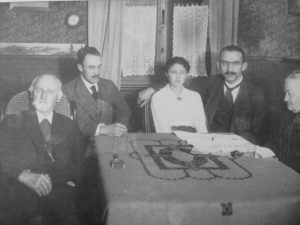Author’s Note: If you would like the entire translation reference guide for your marriage certificate, it can be found here. If it’s handwriting help you are looking for, consider joining our Premium group – weekly access to live “office hours” where you can ask Katherine your tricky transcription and translation questions – and get immediate answers (also includes a download of the marriage certificate reference guide).
When researching your genealogy, marriage certificates can be a gold mine of clues to your ancestors’ lives. Names, occupations, places of residence and other interesting tidbits of information often fill the short documents to the brim. However, if you don’t speak German, deciphering these clue-filled pages can be a bit of a challenge (not to mention the difficulty of deciphering the handwriting!) But what if it didn’t have to be so challenging? Below, seven common phrases you might find on German marriage certificates and what they mean:

1. “Vor dem unterzeichneten Standesbeamten”: “Before the undersigned registrar”. This is often the beginning sentence of the marriage certificate, underneath the city and date it was issued.
2. “der Persönlichkeit nach bekannt/der Persönlichkeit nach _______ anerkannt”: “His (or her) identity known”/”His (or her) identity verified by_________”. In the first instance (bekannt), the registrar personally knows the individual and does not need a form of identification. In the second instance (anerkannt), the registrar verifies the person’s identity with a form of identification, filling in the blank with the ID that was presented. It could be a passport, birth certificate, baptismal certificate, military ID, etc.
3. “geboren den_____ des Jahres_____”: “Born on the (day, month) of the year____”. The year was usually written out in letters rather than numbers.
4. “wohnhaft zu”: “residing in/resident of”. This is then followed by the name of a city or town.
5. “Sohn/Tochter des_____”: “son/daughter of the______”. This line is normally followed by the occupation of the father, the father’s name, his wife and his wife’s name. If the parents are deceased or if there is any other relevant information about them, it is also mentioned here.
6. “Zeugen”: “witnesses”. The name, age and occupation of the witnesses, as well as how they were identified, are listed underneath the witness section (usually the second page of the marriage certificate).
7. “Vorgelesen, genehmigt und unterschrieben”: “Read aloud, approved and signed”. The names of the newly-married couple, as well of the names of the witnesses, are signed underneath this phrase.
With these tips, deciphering marriage certificates should become a little bit easier. And if you would like to consult a professional translator, don’t hesitate to contact me here – I would be happy to be of service.







13 Responses
Thanks for this great post. It has saved me the tiring process of translating the printed text on the form. 🙂
I am having a hard time reading the old German script on what I believe to be my grandparents marriage certificate. It says Befcheiigung der (and then what look s like ” Chefchliefzung” which is not a word I can find anywhere. It has both my grandparents’ names listed on it. Can you help me figure this out?
Thanks.
Hi Erika,
Thank you for your comment. Can you send me an e-mail to [email protected] and we can go from there?
Best,
Katherine
I too am researching my great grandparents wedding certificate. I believe what you are trying to translate is Bescheigung der Ehschlieβung which means Certificate of the Wedding.
Happy New Year!
If you’re still looking for an answer, it’s “Bescheinigung der Eheschliessung” (= certification of the marriage). You’re right, it’s a marriage certificate.
The letter “s” often looks like an “f” in old documents.
I know the document I have is my great grandparents marriage certificate but I cannot read what the last name of my great grandmother is.
Hi Melissa,
If you’re interested in having it translated, feel free to send me an e-mail at [email protected]. If you just need help with a few words here and there, you may want to check out the Premium membership – I help people decipher words they are having trouble with once a week! https://germanologyunlocked.com/premium
My grandparents got married in 1944 in berlin. I recently got a copy of their marriage record and the parents names are missing, is this common for the time period or do I just have the short form version? Are there other forms that they had to fill out before getting married that I could possible get that would have their parents names listed? thanks
Hi Gregory,
In my experience, usually the parents’ names are listed, but it depended on the parish. I was actually just translating some forms this weekend where the parents’ names were written on the earlier versions of the records (1800s), but as we moved into the 1900s, they stopped being listed. So that could have been the norm in some areas. That being said, I’ve translated a good number from Berlin, and I usually do see the parents there. Some parishes required an “Aufgebotschein”, I believe – a certification of marriage banns, but I’ve never actual seen one of these – I’ve just seen them listed as a means of identification. Otherwise, perhaps searching for birth certificates would be best!
I have several hand written birth certificates from Bromberg, present day Bydgosz, Poland, that I would like translated from German to English. Would you be able to help and if so, what is your price?
Hi Paul – Please send me an e-mail via the contact form on the website. Thanks!
Can you please tell me what religion is noted in the example you posted? I have what seems to be the same word on a document I am trying to translate and cannot decipher the handwriting. Thank you!
That’s “evangelisch” – Protestant!